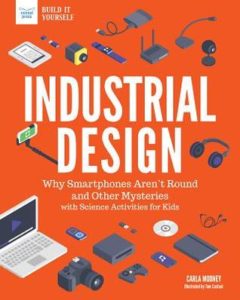“Shaping the World: Industrial Design”
Why are chairs shaped like…chairs? How do engineers get ideas for improving the design of cars, phones, packaging—everything?
Since the earliest times, people have searched for better solutions to specific problems. They have tried to improve stone tools, cooking pots, weapons, and more. When creating each new item, they have thought hard about it—what problem are they trying to solve, what are they trying to accomplish, how can they make it work better?
Answering these questions, they made a design. Through design, people have created the key inventions of our civilization.
You might not know it, but you, too are a designer. Have you ever rearranged your room or desk to better suit a specific use? Maybe you wrote a quick computer program to make your gaming system work better. By thinking about what needed to be improved and finding a way to improve it, you used design skills.
So what’s industrial design? Industrial design is the process of brainstorming and planning every aspect of a product before it is made in mass production. Most of the things we buy today are made in a factory. Someone, an industrial designer, decided what the product would look like, how it would work, and developed a process for it to be manufactured.
Industrial design includes making decisions about how a product is used by a person, what technologies it uses, the materials it is made from, and how it looks and feels. Industrial design is a problem-solving process.
People have been designing things since the first fire pit! As technology grows increasingly complex, the methods of design have grown more sophisticated, but the beginning spark is the same. Spot a problem? Design a solution!
Try your hand at industrial design with these hands-on projects!
DESIGNER VS CRAFTSMAN
The growth of factories and mass production allowed companies to produce goods that were affordable for many people. At the same time, separating design from manufacturing can cause some problems. In this activity, you will explore some of the differences between craft-based design and mass production.
To begin, you will play the role of a craftsperson. Choose something that you can make, such as a piece of art, a stick picture frame, a simple wooden train and tracks, or a magnetic clip. Gather your supplies and get to work designing and making your item. Think about the following questions.
What design decisions did you make for your item?
When did you make these decisions—before you started working or while you were making the item?
How were the design process and the making of the item connected? How were they separate?
Now, imagine that your item will be mass-produced in a factory. You are still the designer, but will not be making the items. How will you convey your design ideas to the people who will manufacture and assemble the items? How will you ensure that the mass-produced items match your design, regardless of who makes them?
Have several friends or classmates follow your design instructions and make the item without you. After they have finished, compare their items to your handcrafted original.
Are there any differences? If so, what are they?
What difficulties did you and your team encounter while mass-producing the item? Why do you think this occurred?
What problems will it cause if there are differences between a design and the manufactured products? What about between the products themselves?
What could you do as the designer to ensure there are very few differences between the original design and mass-produced items?
Try This!
Think about how ornamentation affects mass-produced industrial design. Ornamentation is everything added to an object for decoration. It could be the type of finish or painting on an object, scrolls in woodwork, or even added jewels or metalworking. What is the effect of ornamentation on an object’s form, function, manufacturing process, and cost?
DESIGN A CHAIR
Design solves a problem and meets a need. When industrial designers create and improve products, they make sure their designs meet the needs of users. In this activity, you’ll design a chair that meets the needs of a specific type of user.
Consider the following chair users.
An 80-year-old man who walks with a cane. He spends most of his day in a chair, watching television. It is difficult for him to get in and out of a chair.
A 15-year-old student who spends eight hours a day at school. He has a large, heavy backpack that he carries from class to class. In every class, he needs a place to work and store his backpack.
A 30-year-old marathon runner who spends much of her time moving. Because she often has sore muscles, she prefers a cushioned, comfortable place to relax and prepare for the next day’s run.
Choose one of the users and make a list of what they need in a chair. How are these needs related to design requirements for a chair?
Choose a variety of materials to work with. Possibilities include black permanent markers, paper, scissors, corrugated cardboard, pipe cleaners, modeling clay, cotton balls, tape, and toothpicks.
Following the design process and considering your design requirements, design the chair.
Draw several sketches of the design. What elements will you use in the design? How do these elements meet design requirements?
Using your materials, make a simple model of your chair.
Evaluate your chair’s design. Does it meet the design requirements? Does it work as intended? Is it aesthetically pleasing?
Test your design by having other people evaluate the chair. What changes or improvements do they recommend?
Retest it with potential users. If needed, redesign your chair based on the testing feedback. After you have the final design, consider the following questions.
What did you change during the design process? What did you learn from your models and prototypes?
What materials did you enjoy working with the most? Which did you enjoy the least? Why?
Try This!
Try building a model of the same chair using different materials. How do different materials affect the design? How does the choice of materials affect how well the chair meets the design requirements?
REDESIGN A KITCHEN UTENSIL
There are a lot of utensils in the kitchen—knives, forks, spoons, whisks, peelers, pizza cutters, ice cream scoopers, spatulas, and more. Can you find any that could be improved by industrial design?
With an adult’s permission, take an inventory of your kitchen utensils. Consider the following questions.
What types of utensils do you have? How many of each kind?
What materials are they made from?
Are they ergonomic?
Are any utensils hard to hold or difficult to use?
Are any broken or rusty?
Can you use them right-handed or left-handed?
Do the handles wobble and make gripping the utensil difficult?
Does the utensil have sharp edgesthat cut into your hand when holding?
Do they look aesthetically pleasing?
Choose a utensil to improve through industrial design. Follow the steps of the design process:
Understand the problem
Define design requirements
Generate ideas
Choose the best solution
Develop the solution
Make a model/build prototype
Test and redesign
Present your new and improved utensil design to family members. What are their reactions?
Try This!
Can you design a product to organize your kitchen utensils?
About the Author: Carla Mooney has written more than 70 books for children and young adults. Her work has appeared in many magazines including Highlights, Faces, and Learning Through History. Carla lives in Pittsburgh, Pennsylvania.
Website: carlamooney.com
Facebook: facebook.com/carlamooneyauthor
Industrial Design: Why Smartphones Aren’t Round and Other Mysteries with Science Activities for Kids
By Carla Mooney
Published August 3rd, 2018 by Nomad Press
About the Book: What is industrial design? Why do microwaves open with a swinging front door? Why aren’t smartphones round?
In Industrial Design: Why Smartphones Aren’t Round and Other Mysteries with Science Activities for Kids, readers ages 10–15 engage in and learn about the engineering design process from its earliest beginnings, when individuals designed and crafted their own tools, to today, when engineers work to find the best design for products that are then manufactured in bulk by automated machines. Engineers consider the user experience of every product they design to ensure that users have the best experience possible. Good design combines the right materials, colors, details, and form to make a person want to buy and use a product. A well-designed product is easy to use and does what it is meant to do!
Thank you Carla for these classroom and independent friendly inquiry activities!


